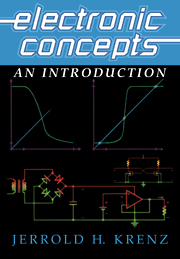Book contents
- Frontmatter
- Contents
- Preface
- 1 ELECTRONIC SYSTEMS: A CENTURY OF PROGRESS
- 2 THE SEMICONDUCTOR JUNCTION DIODE: THE BASIS OF MODERN ELECTRONICS
- 3 THE BIPOLAR JUNCTION TRANSISTOR: AN ACTIVE ELECTRONIC DEVICE
- 4 THE METAL-OXIDE FIELD-EFFECT TRANSISTOR: ANOTHER ACTIVE DEVICE
- 5 NEGATIVE FEEDBACK AND OPERATIONAL AMPLIFIERS
- 6 ELECTRONIC POWER SUPPLIES
- APPENDIX A FABRICATION OF INTEGRATED CIRCUITS
- APPENDIX B THE DESIGN PROCESS
- Index
2 - THE SEMICONDUCTOR JUNCTION DIODE: THE BASIS OF MODERN ELECTRONICS
Published online by Cambridge University Press: 05 June 2012
- Frontmatter
- Contents
- Preface
- 1 ELECTRONIC SYSTEMS: A CENTURY OF PROGRESS
- 2 THE SEMICONDUCTOR JUNCTION DIODE: THE BASIS OF MODERN ELECTRONICS
- 3 THE BIPOLAR JUNCTION TRANSISTOR: AN ACTIVE ELECTRONIC DEVICE
- 4 THE METAL-OXIDE FIELD-EFFECT TRANSISTOR: ANOTHER ACTIVE DEVICE
- 5 NEGATIVE FEEDBACK AND OPERATIONAL AMPLIFIERS
- 6 ELECTRONIC POWER SUPPLIES
- APPENDIX A FABRICATION OF INTEGRATED CIRCUITS
- APPENDIX B THE DESIGN PROCESS
- Index
Summary
Although the invention of the transistor at Bell Telephone Laboratories in 1947 was destined to revolutionize the field of electronics, the initial response to the public announcement on June 30, 1948, was anything but overwhelming. The New York Times carried the news in its daily column “The News of Radio,” which dealt with new radio shows. Near the end of the column appeared the following (New York Times 1948):
A device called a transistor which has several applications in radio where a vacuum tube ordinarily is employed, was demonstrated yesterday at Bell Telephone Laboratories, 463 West Street, where it was invented.
Three additional brief paragraphs completed the announcement. A more fitting debut of the transistor was provided by three letters to Physical Review directed toward the scientific and technical community (Bardeen and Brattain 1948; Brattain and Bardeen 1948; Shockley and Pearson 1948). “The Transistor – A Crystal Triode” appeared as the cover article of the September 1948 issue of Electronics (Fink and Rockett 1948). Although the terms crystal triode and semiconductor triode were used to describe the transistor, by way of analogy with the vacuum tube triode (Figure 1.4), the name transistor has prevailed. The term transistor, that is transfer resistor, is attributed to John R. Pierce (already mentioned in relation to satellite communication) (Shockley 1976). Thus commenced the era of solid-state electronics in which transistors not only play an important role but within which entirely new electronic devices have been developed.
- Type
- Chapter
- Information
- Electronic ConceptsAn Introduction, pp. 59 - 132Publisher: Cambridge University PressPrint publication year: 2000

